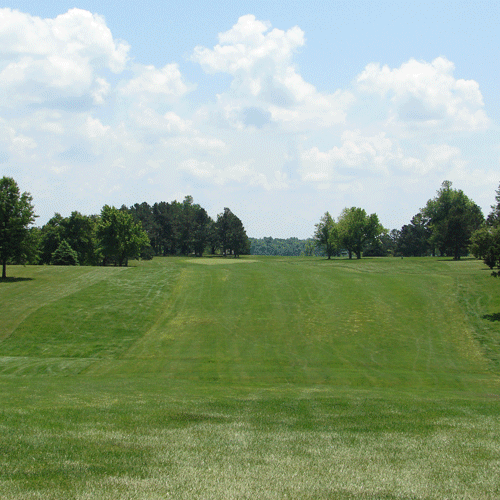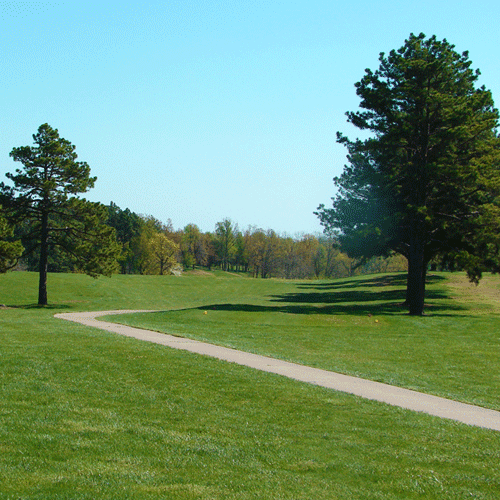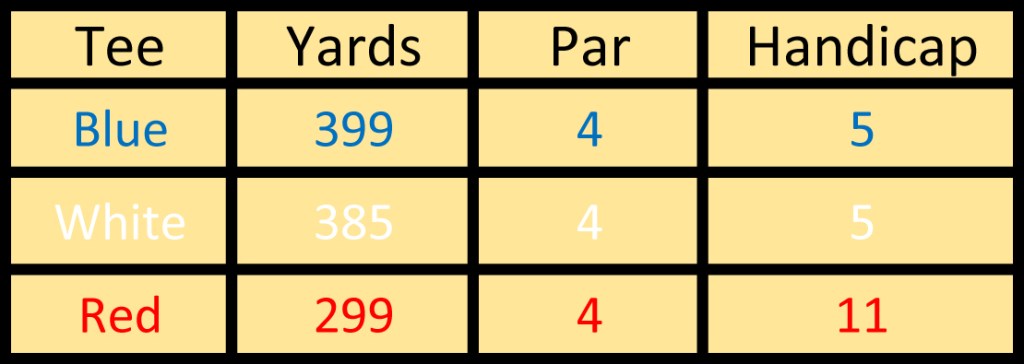The opening hole is a straight ahead, uphill par 5 with the drive having to carry a large lake directly in front of the tee.
Measuring 492 yards, this hole has a small grove of trees on the right of the fairway and also a line of trees on the left side. The second shot should put you in position for an approach with no more than a short iron. The green is a very large two-tiered green sloping from back to front. Note the pin placement on this green as the front tier location is much easier than the back in chipping and putting. There are large mounds on the left side of the green that can present a problem on any pitch from these mounds to a back pin location. Birdie is a very doable score on this opening par 5.


This short par 4, 320 yard hole, presents a tougher par than you might first imagine.
The drive must avoid three large bunkers on any shot hit to the right side of the fairway. A line of trees line the left side of the fairway all the way to a small pond at the end of this dogleg right hole. This water hazard extends behind the green to penalize any shots hit long. This two-tiered green, much larger on the elevated right side than the lower tiered left, provides a tough target to approach with a short iron. When the pin is placed on the lower left position there is very little putting surface on which to land. Taking this hole for granted can be a big mistake on the scorecard!


Playing at 156 yards, this par 3 is guarded by water on the left side of the fairway all the way to the left rear of the green.
Depending on the choice of tees there can also be a carry completely across the water hazard. The very deep green is banked so that any shot landing left of the green probably rolls into the water. A rail fence marks out-of-bounds from tee to green on the entire length of the fairway on the right. The large green is surrounded by mounds on the right side and rear of the putting surface.


Hole #4, a 390 yard par 4, requires a straight drive avoiding the trees and out-of-bounds fence on the right side of the fairway.
There is also an extremely large “sinkhole” that can come into play on long drives missing the fairway to the left. The approach shot is unopposed by traps or hazards but must find a green with lots of break and tilted to the left. Shots that carry long on this hole can present a tough up and down to save par.


This 429 yard, par 4, dogleg right is best played by taking your drive over a large tree guarding the right corner of the turn.
A line of trees follows the left side of the fairway starting approximately 200 yards from the green. A drive hit to the left side of this fairway can roll into this tree line blocking your approach. A large horizontal green provides a wide target but with very little depth that can allow for many shots to carry long. Again, no bunkers but the green slopes from left to right presenting speed problems on chips and putts. A steep bank and trees also lie directly behind this green.


An uphill, dogleg left, par 4, playing at 407 yards requires a drive carrying the hill and setting up an approach shot to an elevated green.
Many times this shot finds the ball lying in a sloped area of the fairway that does not offer a level lie. While normally not coming into play, any shot hit extremely right could find the “sinkhole”, a deep depression that could result in a lost ball. The reasonably flat green is horizontal in shape and has a high bank off the green to the left side.


This beautiful par 3, with a carry of 173 yards to the pin, offers the golfer a unique shot over a large, deep “sinkhole” for much of the distance.
Dense trees flank both sides of this hole that will knock down any shot hit too far off line or without the proper height to carry over them. An extremely wide, shallow green that slopes heavily to the right is guarded by a bunker on the left front and steep banks on the left side. Due to the long carry, this is a tough green to hit and get close to the pin. Par is a very good score and birdies are scarce!


This straight-away, 380-yard, par 4, slightly uphill on the drive presents an approach to a relatively small green.
There is a large tree on the right side of the fairway that will possibly catch a drive that is hit to that area. On the left side of the fairway, there is very little trouble to be encountered. With no bunkers surrounding the green an open shot is normally available. Shots that carry long of this green are faced with a very tough pitch or chip down a fast slope.


The ninth hole, a 470 yard, par 5, requires a very accurate tee shot to an uphill slope flanked by trees on both sides of the landing area.
Drives that find these trees normally are blocked on the second shot. There is also a large bunker at the very top of the hill to catch an unlucky long drive. This huge green is reachable for long hitters in two with a putt for eagle a real possibility. If the second shot is played short of the green you will be faced with a short iron to the green that is very elevated offering no view of the green itself. There are two bunkers directly behind this double green that separates hole #9 and hole #18 as well as a huge bunker to the right side. Another bunker protects the lower left side. Position on the green is very important as three putting is not unusual on extremely long, curling putts.


The opening hole on the back nine is a straight par 5 playing to 510 yards.
Following a drive into and over a hillside, you are faced with a second shot down a wide, accommodating fairway. The third shot is played to a large green that is steeply sloped from back to front. It is not in your best interest to be pitching from behind the green due to the quick downhill pace of the putting surface. A small sand trap guards the front right of the green. Your best angle of approach is generally center to left side of the fairway.


Hole #11 is a short par 4 at 310 yards.
But, do not let the distance mislead you. There is a water hazard covering the entire front of the green left to right that catches long drives with a retaining wall that leaves very little room if the approach is short. The hole is also protected by large mounds behind the steeply sloping green that again penalizes approach shots that carry long. An approach shot from the left center of the fairway is usually the best angle of attack to the putting surface.


This 490 yard, par 5, requires a drive to a large landing area but with a slight slope to the left.
A drive to the right side of this fairway will normally wind up in the center. A drive that is hit to the left side of the fairway usually moves to the left and into trouble. The second shot offers the opportunity to go for a tree protected green or you can choose to lay up for a safer short iron. There is also a large, vertical rock wall to the right of the green that presents a tough obstacle to fly if you miss to the right on you approach. Trees also come into play along the left side of the fairway.


Now for some real adventure!
This 385 yard, par 4, is a ninety degree dogleg left that offers the option of a long, straight drive setting up a mid-iron to an elevated green or taking a risky shot with your drive over a long stretch of trees and going directly at the green. The result may be on the green, a short chip or pitch, or hitting three from the tee. It’s a gamble! A large bunker also protects this very large, flat green.


This long par 3, at 215 yards from the back tee,
presents an out-of-bounds fence on the left side, huge bunkers on the right side, and behind this large, elevated green. Even if you hit this green you may still have an extremely long, twisting putt. Be sure to hit enough clubs. Most shots land short into the hillside. This is a very dangerous hole for your score with a big number entirely possible. Par is a great score!


The third par 4 on the back nine, this hole is a dogleg left playing at 375 yards.
The drive presents a problem with pulled tee shots facing trees and out-of-bounds on the left and a sand trap and trees potentially blocking your approach shot from the right. The center of the fairway is a great place to be for a proper approach. Another large green seems to present an easy target but offers very little room for errant shots with trees and out-of-bounds on your left, more dense trees on your right and a steep bank directly behind the hole. The green slopes gently all the way from back to front with many undulations.


Hit ’em straight on this tight, 390-yard, par 4.
You are faced with trees on both sides of the fairway that come easily into play. Drives that are pushed to the right side of the fairway are susceptible to rolling into trouble. The approach shot is hit to an extremely elevated, large two-tiered green that is very easy to three-putt. Take a good look at the placement of the flag. If you are on the wrong tier you are faced with a very difficult putt. A large bunker lies to the right side of the green. Once again, shots that carry long are left with a high degree of difficulty in getting close to the hole on your pitch or chip.


Go straight at this par 4, 398-yard hole.
A wide receptive fairway, with the only real problem being a line of trees way to the right, sets up for a tough approach shot to this small, left-banked green. Shots hit short tend to bounce hard left making for a difficult up and down. This hole is a tough par and birdie is a scarce commodity requiring an extremely accurate iron shot.


The 165-yard, par 3, eighteenth hole shares a huge double green,
divided by a large bunker, separating the ninth and eighteenth greens. Additional bunkers guard the left front and right side of the green. The putting surface is very deep front to back and the hole can play short or long depending on pin placement and wind direction. Long putts with a great deal of movement are the norm on this green. Three putts? Very possible!


